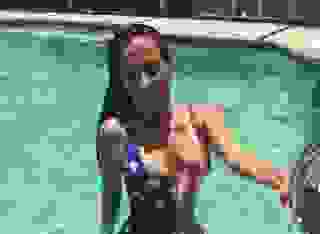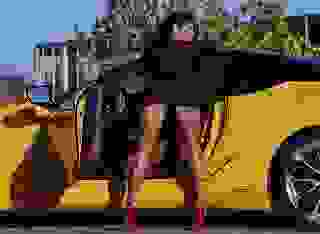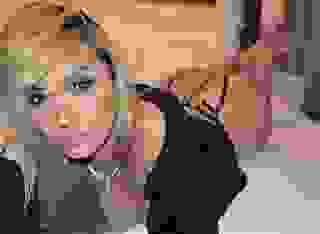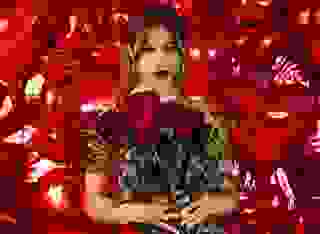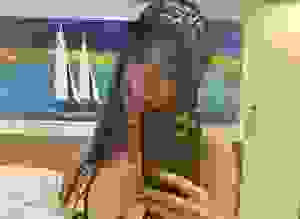- Romance
- Massage Mat Pt. 02 Ch. 01
Note: You can change font size, font face, and turn on dark mode by clicking the "A" icon tab in the Story Info Box.
You can temporarily switch back to a Classic Literotica® experience during our ongoing public Beta testing. Please consider leaving feedback on issues you experience or suggest improvements.
Click here"To Paint the Portrait of a Bird"
This is a story about how Beth and Angie continue to evolve as their unique life journeys continue.
Some disclaimers are in order:
This story contains no incest—actually the proportion of sex to story is relatively small for a Literotica story. It's therefore not really an erotic story that's intended to turn you on (but if it happens, hey, go with it!).
The story focuses on love and passion rather than on lust and sex. It's about struggling to become an artist and to become creative. And it's about struggling to find one's place in the world. These larger issues tie it into the Massage Mat series as much as the characters do.
This may not be, therefore, a great story if you're only looking for masturbation fodder.
It will likely be most enjoyable to folks who are interested in seeing how these characters develop. I've tried to tell a story that I find interesting and compelling—and I hope you do too.
The whole "Massage Mat" series would be the ideal lead-in to this. If you haven't read it, at least part one is crucial (and it's very short). Parts four and nine also develop the relationship between Beth and Angie in ways that make some episodes more meaningful.
And: You may want to read the poem that inspired a lot of the story. It's called "To Paint the Portrait of a Bird" and it's by Jacques Prévert. For copyright reasons, I can't quote it here, but if you google it you'll get many hits—including a nice YouTube video version.
One final disclaimer. I apologize in advance for the cigarette smoking—I know that puts some folks off. It is, though, an important part of the story and is used to give some deeper insights into characters' personalities. I'm sure they all will get on the patch and quit before any serious health issues develop. Enjoy!
Where was she?
Angie ran through the house, searching. She had suddenly sensed that something was horribly wrong. Beth had been happily working in the studio. Then the world seemed to turn upside-down.
She stopped. Now she heard it—the sound of someone sobbing.
Where was it?
She couldn't tell from the sound, but in an instant she knew. It was downstairs. Downstairs in the room where they had first met, the place where they had fallen in love and where they had first made love looking out at the hills and the starts and the valley below.
She must have gone there as a wounded animal returns to its den. When pain and fear and suffering blot out all thought and there is only the raw need for comfort and safety.
The sobbing filled the darkened room, as though her very soul were in torment.
Angie ran to her, crying out, "Beth! Beth darling. Oh my God, what happened?"
Beth didn't answer, she only sobbed uncontrollably. Angie took her in her arms and held her, rocking her as one holds a suffering child. Beth wrapped her arms around Angie and held on as though she would never let go, shaking and heaving with her sobs.
Angie covered her with kisses, holding her, comforting her, telling her that it would be all right—and all the time wondering what could be so wrong.
At last, Beth cried herself out and hung limply in Angie's arms. Her body still shook with silent sobs, but clearly the worst was over.
Once again, Angie asked, "Darling, what's wrong?" She paused, and getting no reply pressed on, "Please tell me, Beth. I'm worried about you. I want to help."
Beth raised her tear-streaked face and looked at her. She wiped the tears away with the backs of her hands and sat up. She sniffed and wiped her nose on her sleeve like a little girl.
"It's so useless, Angie," she said, her voice heavy with despair. "I try and try and try. And it's just useless. I can't make art—I don't know what ever possessed me to try. But I'm horrible at it. And it hurts so bad to realize it—to see how empty my soul is." Her face wrinkled and tears streamed down once more.
Angie recalled how she had encouraged Beth to explore new horizons since their marriage. Now that Beth no longer needed to work, they both had time to follow their dreams. It had taken a while, but eventually Beth confessed that she had always dreamed of being a painter. It had been her secret fantasy since she had been a little girl.
It was so like Beth to be drawn to an art that could be so sensually pleasing and rooted in reality while having the potential to soar into the infinite. Angie sensed at once it would be an important path for her wife to follow. And of course, she became 100 per cent devoted to helping Beth achieve her dreams.
They took a "Painting 101" class together at the local community college. Beth was too shy to go alone at first, but once she got started there was no stopping her. She took every other art course she could find within 250 miles and then began to seek out lessons from great teachers.
And she painted incessantly. Her instructors had all stressed that there was no substitute for practice, and Beth was a passionate student. Their farmhouse was soon overrun with still lifes: fruit scattered in every imaginable way on tables, in baskets and bowls, pictures of flowers of all types—in nature and in floral arrangements. Then nuts and other objects entered. Their collection of pewter mugs, brass knick-knacks and alabaster ornaments had exploded, and Beth spent hours capturing all of the textures, fissures, shapes, shadows and colors onto canvas.
Several months thereafter were devoted to seascapes, including an impressive array of storms at sea and sailing ships—with painstaking attention paid to every fold and wrinkle of dozens of sails.
Then there was the landscape phase. It seemed that an entire summer was spent in the pursuit of techniques for creating the perfect tree. Not mere birches or poplars, of course (those were easy), but of majestic old oaks with craggy bark and complex foliage. Knives, brushes of every shape and material (hog, pony, boar, sable) and techniques—to layer or not to layer?—consumed Beth at every waking moment. The only virtue from Angie's viewpoint was that brushes rejected from foliage painting seemed to find their way into the bedroom for highly arousing sex play.
And of course another round of flowers and grasses—landscapes need flowers and grasses. All of this vegetation, of course, decorated hills, valleys, roadways, highways, byways, streams, rivers and lakes. Upon these lavish natural settings houses, barns, haystacks, cows, horses and windmills flourished—the list of projects seemed as endless as Beth's energy to make each one absolutely perfect. Angie marveled at how Beth could spend an entire day laboring to create an exquisitely detailed cloud as a mere background detail.
The following autumn, they put thousands of miles on their cars, traveling around to do architectural studies of old buildings. Then thousands more, doing architectural studies of new buildings.
But Angie's most irritating memories were of the semester of portrait class. At first it seemed like such a win-win situation. Angie loved to meditate, sitting motionless for hours at a time, and Beth needed a subject for her portraits. But being scrutinized and reproduced on canvas in painstaking detail is not conducive to meditative relaxation, nor is nude meditation while artfully draped across a divan particularly productive. And of course any portrait of Angie had to be absolutely perfect.
So after "Sunrise Angie #18," patience ran out for further sittings, and Beth moved on to self-portraits and, of course, to a gazillion portraits of Jason done from memory—both in and out of his hockey uniform. Having seen Jason in both states, Angie could fully appreciate the detailed accuracy of Beth's renderings. Clearly, Beth had become a highly skilled artist.
So seeing her wife sobbing in frustration at her lack of ability had Angie baffled.
"Beth," she said gently. "Your pictures are beautiful. You know I love them," she paused. "But it's not just me. Even other artists and people who know about art talk about how good your stuff is." She ruffled Beth's hair lovingly before continuing, "I think maybe you just need some sleep."
Beth sat up, a scowl crossing her face. "I know I can make pretty pictures," she said grumpily. "That's not the issue." She looked around, as though searching for the right words. "Look," she tried again, "I can make them pleasant to look at, but they don't make you feel anything." She paused and looked directly at Angie. "Right?" she asked. It came out like an accusation.
Angie was too honest to evade the question. She nodded her head. "Well, I guess that's right," she said softly. "They're beautiful, but I don't really feel anything when I look at them—except that I'm so proud of what you can accomplish." She laid her hand on Beth's heart, as if to apologize. "But Beth," she added hastily, "I'm a redneck from the backwoods. I don't know anything about what real art should be. I'm sorry."
Beth sighed. "Angie," she said tiredly, "there is so much inside of me that I want to put on that canvas besides the image. I know it's there—I can feel it. And it's there when we make love. It's there when we talk. It's there all the time. Except for when I'm trying to get it on the canvas. Then it goes away and hides." Tears ran down her face again. "If it were there you would see it—you would know it. You, of all people, would know it." She covered her face with her hands and sobbed, "It's just not there. I can't do it." Angie comforted her as Beth continued to grieve. Suddenly regaining her composure, she pushed Angie back.
"You know what?" Beth added bitterly, "I don't even know what really great art looks like in person. I've only ever seen the stuff on slides in art history class. I've never stood in front of a Michelangelo or Picasso or Renoir or anything." She shook her head and looked down.
"It's just hopeless" she sighed.
Angie thought for a moment, then smiled. She hugged Beth and gave her a kiss. "Well, we can fix one part of that puzzle, and probably have a lot of fun at the same time," she said brightly.
Beth looked at her questioningly.
"Well, duh," Angie told her. "If you want to see great art, let's go. Let's go to Paris and see the Louvre and the Musee d'Orsay and wherever else we can think of. You'll see your art—and we'll have a chance to see some of the world and to travel together." She looked lovingly at Beth and kissed her. "How's about it, lover?" she asked. "Want to come to the City of Romance with me?"
Beth kissed her back. "Yes I do," she replied. "You're right, as usual. It would be good for a lot of reasons."
They spent the next week planning their trip. As they got more into it, they both got very excited about it. It seemed like a great adventure to take together.
One day, though, Angie came in from shopping with a concerned look on her face. "Did you buy the airline tickets yet?" she asked Beth urgently.
"No," Beth admitted, a guilty expression on her face. "I got working on a goddamn bush and it's taken most of the day. I'm sorry, Angie." She poured herself a cup of coffee from the pot that had become a constant fixture in their house since she had become passionate about painting.
"As long as you're talking about a painting and not another woman I don't care," Angie quipped as Beth choked on her coffee. "But we should think about changing our travel plans." Beth looked at her.
"I ran into a local artist in the store," Angie explained. "I don't know if you've ever met him, but he became sort of a local celebrity a while back. I knew him up North—before I moved down here. Anyway, I think he's had a show or two in New York, and some museum or other got interested in his work—but that may have been before you were spending time around here. I don't really know much about it, but apparently he had quite a 15 minutes of fame." She poured herself a cup of coffee
"Anyway," she continued, "I ran into him and we got talking. He asked about our trip and I told him what we were doing. He was very nice—he listened politely and everything.
"Then he said. 'I wouldn't start in Paris. It's too radical and nouveau. You guys should start in Italy. Go to Venice. See St. Mark's and all of the great art there. Then go to Florence—the Ufizi, go see David. Look at cathedrals in Italy. Then you can go to France. And besides the mausoleums—the Louvre and d'Orsay—go to the Pompidou Center. See something done in the last 200 years, for God's sake. And stop in New York on your way back. The Met and MOMA. Beth has to see those. And the other great American museums—National Gallery, Chicago, Detroit, San Francisco, Seattle, Philly. There's a nice Dali museum in St. Pete, Florida. You can see a lot just here in the States.'"
Angie took a sip of her coffee. "So I think we should do all of that. We could do it in a two months or better yet, three. What do you think?"
"Just because this random guy said so?" Beth asked, warily.
"Well, he's not a 'random guy,'" Angie huffed. "Like I said he's a pretty well-known artist—at least he's supposed to be. And he's a friend. I've known him since my college days and he's a pretty solid guy. He actually lives down the road on the other side of the hog farm, so I've seen him around here before," she added. "So, does that make you less suspicious?"
"I guess," Beth said, then pondered a moment. "But anyway, who cares? A couple of months travelling around with you? I think that I am the luckiest woman in the universe," she concluded.
"Perdonatemi signorina. Dove è Guggenheim?" Beth's Italian lessons were paying off for them in Florence.
The smartly attired young woman stopped and smiled. "Americane? Bene. Bisogna attraversare il Canal. Prendere il Ponte dell'Accademia. Poi vai a sinestra, e di nuovo a sinestra in Calle Sant' Agnese. Remere su quelle strada—e troverete infine venire al Guggenheim. Capisci?"
"Si. Mille grazie," Beth smiled as the woman disappeared into the crowd.
"She says to go straight along here and cross the canal at the Academy Bridge, then two lefts and just follow that street. That should take us all the way there," Beth explained.
"Damn. You're great at Italian," Angie said, impressed.
"Well, while you were making a fortune in the stock market I was doing a little studying of my own," Beth said. "Not as lucrative a field, I admit, but it's handy at times." They laughed and headed off. Both were grateful to be seeing some more modern art after being overwhelmed by the sumptuous beauty of St. Mark's and the other Medici-era art of Venice.
As they walked, Beth brought up something that had been on her mind for a while. "So this artist friend of yours," she said as they strolled along. "Is he like an art professor or something? I mean, how does he make a living?"
"I don't know. I think he just sells paintings," Angie replied. "He's always jetting around, so I guess he's doing well. He's even affected an artsy name. When I first knew him he was Myles Ziglowicz. Then he shortened it to Myles Z., but I think he's now using Myles Zee."
"Very cute," Beth said with a chuckle. "I think that's my problem. Maybe I should use Elizabeth Emm. How does that sound?"
"Dreadful," Angie replied, laughing. "And not like you at all. I think good old Beth Miller is perfect. You'll make that name into something special, I think."
Beth hugged her as they turned a corner and the Guggenheim building came into view.
"Ready for more art?" asked Beth.
"Ready or not, here it comes," quipped Angie. "I've got the euros for the tickets right here. Let's go."
After having been elbow to elbow with tourists all day, they were relieved to find that the Guggenheim was blessedly un-crowded. They went through the main collection and were about to leave when Angie noticed a crowd of people in an anteroom.
Nearing the room, they saw a sign indicating a special exhibit of contemporary American works. The room was not particularly full, but there was a group of people clustered around two pictures facing each other in a corner. Curious, they walked over to see what was so captivating. Beth noticed it first.
"Holy shit," she whispered. "Look at this one."
"What?" asked Angie. Then, following Beth's glance, she froze. "Oh. Wow."
There was a photograph of a nature scene from somewhere in Africa. It was overflowing with a mesmerizing array of vibrant foliage, upon which herds of exotic animals cavorted. The photographer must have painstakingly selected the location and waited hours for this combination of animals to come together. He clearly had paid careful attention to the mechanical details of photography as well. The picture was in sharp focus, and the colors were rich, deep and true.
But then.
As they came closer, they began to see that this was not a photograph. Rather, it was an unbelievably life-like painting. They had to bring their faces almost to the canvas to detect brush strokes, but it obviously was a painting.
"Oh my God. Look at that," Angie said, nudging Beth.
"Look at what?" Beth asked, her eyes still glued to the canvas.
"Look at the plaque on the wall," Angie said. Something in her voice made Beth obey instantly.
"'Oh my God' is right. Is that real?" Beth asked, incredulous.
The plaque read:
Myles Zee (American, b. 1957)
"This is Not a Painting"
Oil on Canvas
"Why, that..." Angie said. "I knew he was pretty good—but stuff in this museum?"
"This is your friend—the artist friend?" Beth asked.
"It must be. We live down the road on the other side of the hog farm from him—and his paintings are in a museum in fucking Venice, Italy," Angie replied, awed. "I guess he..." her voice trailed off as she realized that Beth wasn't listening. She turned to Beth, annoyed.
"Hey. I was..." she broke off again. Then she said simply, "Fuck."
Beth was staring at the picture on the adjacent side of the corner.
It was the same photograph as the first painting, except that it had been re-arranged. It was as though the artist had cut the first picture into a jigsaw puzzle and re-arranged the pieces so that they fit perfectly—but made a completely different picture. The hindquarters of a gazelle merged beautifully with part of a tree and the horn of a rhinoceros to create the head of a fantastic animal, and the rest of the parts of the picture similarly merged to create a landscape that was surreal, fantastic and incredibly life-like all at the same time.
The effect of the two paintings side-by-side was to make reality suddenly seem very un-real. Beth and Angie instinctively grasped each other as though the floor beneath them had become unsteady. Together, they looked at the plaque and smiled.
Myles Zee (American, b. 1957)
"maybe this one is"
Oil on Canvas
"Ok. This guy is good," Angie said. "I don't know anything about art, but that's good."
"It's not good," Beth said in a reverent voice, "It's magical. I wish I knew how he does it."
A week later, they found themselves in Paris trying to navigate from the Louvre to the Pompidou Center. Beth's map skills were not very good and neither of their phones got cellular data reception in France. Angie had some high school French, but was petrified at the thought of actually speaking to a native of France.
Desperate, Beth begged her to ask for directions. Angie frowned, then plucked up her courage and looked around. She stopped an older lady who looked like she might be patient. Taking a deep breath, she launched in.
"Excoozes-mwah. Noose essayon du trouve luh Sontree Pompidoo," she ventured.
